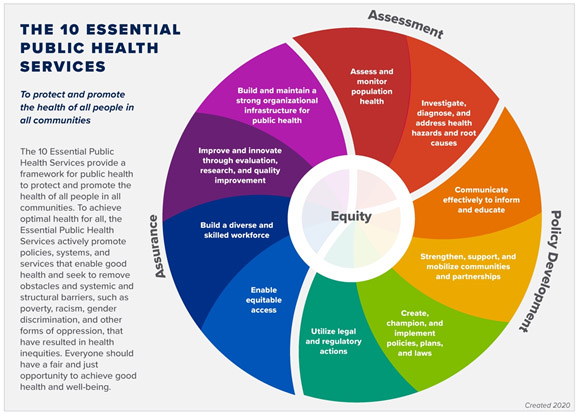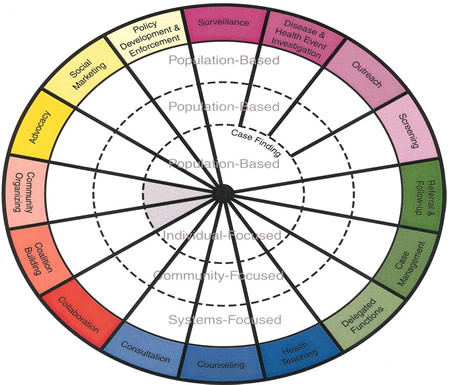Online Course
Nurs 467 - Public Health Nursing
Module 1: Foundational Concepts - Introduction
Basic Concepts
Public health nursing draws from both the public health discipline and the nursing discipline, as well as many others. Read the article by Keller (2011) and review the CPHN Basics slides to learn how foundational concepts from both disciplines were synthesized into the Cornerstones of Public Health Nursing.
3 Core Functions of Public Health
The 1988 Institute of Medicine report “The Future of Public Health” identified three Core Functions of Public Health — assessment, policy development and assurance.. Each core function has essential services associated with it that contribute to the fulfillment of that function (view the slides on the Essential Services). The core functions and essential services are focused on the care of populations as opposed to the care of individuals, although some care may be delivered at the individual level.
10 Essential Public Health Services

The 10 Essential Public Health Services provide a framework for public health to protect and promote the health of all people in all communities. To achieve equity, the Essential Public Health Services actively promote policies, systems, and overall community conditions that enable optimal health for all and seek to remove systemic and structural barriers that have resulted in health inequities. Such barriers include poverty, racism, gender discrimination, ableism, and other forms of oppression. Everyone should have a fair and just opportunity to achieve optimal health and well-being.
- Assess and monitor population health status, factors that influence health, and community needs and assets
- Investigate, diagnose, and address health problems and hazards affecting the population
- Communicate effectively to inform and educate people about health, factors that influence it, and how to improve it
- Strengthen, support, and mobilize communities and partnerships to improve health
- Create, champion, and implement policies, plans, and laws that impact health
- Utilize legal and regulatory actions designed to improve and protect the public’s health
- Assure an effective system that enables equitable access to the individual services and care needed to be healthy
- Build and support a diverse and skilled public health workforce
- Improve and innovate public health functions through ongoing evaluation, research, and continuous quality improvement
- Build and maintain a strong organizational infrastructure for public health
Public Health Interventions (What do PHNs do?)
The Minnesota Model (public health intervention wheel) helps to define public health nursing practice in more detail, according to level of practice (who will be affected) and type of intervention (what will be done).
Level of Practice - Although the primary focus of PHN care is a population, PHNs may deliver care at the individual/family level, the community level, or the systems level.
Interventions - The Minnesota wheel displays 17 interventions that PHNs can implement at various levels to fulfill the core functions and essential services. The color codes indicate interventions that are often performed together, or that are closely related. “Health teaching” is a popular and often-used PHN intervention that helps to fulfill many Essential Services. However, as you will learn when we discuss social determinants of health, teaching is often not enough on its own. As you go through the class assignments and work on your project throughout the semester, use the Minnesota wheel to come up with other interventions besides (or in addition to) health teaching. More detailed information about the Minnesota wheel interventions can be found here.

The Minnesota Department of Health, 2001.
Levels of Prevention
Disease prevention activities can be classified into three levels: primary, secondary, and tertiary. The chart below outlines each level.
This video offers a very short recap of the levels of prevention.